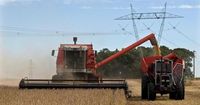American soybean farmers are facing a crisis that many describe as a perfect storm—one that’s been brewing for years but now threatens to upend the livelihoods of thousands across the Midwest and beyond. The trouble began in earnest with the Trump administration’s aggressive tariff policies, but recent developments involving Argentina, China, and Brazil have only deepened the pain for U.S. growers, leaving them reeling from a cascade of lost sales, plummeting prices, and mounting uncertainty.
Earlier this summer, Argentina’s President Javier Milei announced a permanent reduction in agricultural export taxes, dropping the soybean export rate from 33% to 26% and soy by-products from 31% to 24.5%, according to Reuters. Then, on September 22, 2025, Argentina briefly scrapped these taxes altogether in a bid to accelerate foreign sales and inject life into its struggling economy. The move was supposed to last until October 31 but was reversed after just two days when the country hit a $7 billion export cap.
China wasted no time taking advantage. Within hours, Chinese buyers snapped up 42 shipments of Argentine soybeans—2.7 million metric tons scheduled for delivery in November. Market insiders told Reuters that with export taxes suspended, China paid between $2.15 and $2.30 per bushel, a significant discount that immediately put pressure on U.S. soybean prices. The Chicago Board of Trade saw U.S. soybean futures tumble by half a dollar to $10.09 per bushel.
For U.S. farmers, the impact was immediate and devastating. “Every time China turns to South America instead of the U.S., soybean farmers and our farm families here at home lose out,” said Caleb Ragland, president of the American Soybean Association, in a statement to Reuters. “Without a trade deal that removes retaliatory tariffs, farmers like me are left watching key opportunities slip away.”
The situation was further complicated by a $20 billion bailout from the U.S. Treasury to Argentina, intended to stabilize the South American nation ahead of its October midterm elections. A photo captured by the Associated Press showed Treasury Secretary Scott Bessent reading a text from Agriculture Secretary Brooke Rollins that summed up the frustration: “We bailed out Argentina yesterday and in return, the Argentine’s [sic] are removing their export tariffs on grains, reducing their price, and sold a bunch of soybeans to China, at a time when we would normally be selling to China. Soy prices are dropping further because of it. This gives China more leverage on us.”
While the bailout aimed to shore up an ally and bolster President Milei’s populist, libertarian government, it inadvertently handed China a golden opportunity to secure cheaper soybeans while bypassing the U.S. altogether. The U.S. Department of Agriculture and Treasury declined to comment on the fallout, but the numbers speak volumes. China, which received nearly a quarter of U.S. soybean exports in 2024, has not placed a single order for American soybeans since May. Instead, Brazil’s market share of Chinese soybean imports soared to 71% last year, according to the American Soybean Association.
“The frustration is overwhelming,” Ragland continued, as reported by Fortune. “U.S. soybean prices are falling, harvest is underway, and farmers read headlines not about securing a trade agreement with China, but that the U.S. government is extending [$20 billion] in economic support to Argentina while that country drops its soybean export taxes to sell 20 shiploads of Argentine soybeans to China in just two days.”
Farmers across the heartland are feeling the pinch. Ohio farmer Chris Gibbs described the situation as a “severe cash flow mess” and “working capital mess” at the start of the 2025 harvest. “We’re in a hell of a mess here,” he told local reporters. “A working capital mess.” For many, it’s a repeat of the so-called “farmageddon” that followed Trump’s initial trade war with China in 2018 and 2019—a period that saw U.S. farmers lose $27 billion in agricultural exports and a permanent 20% loss in market share, according to the Illinois Soybean Association.
The double whammy of tariffs—both those imposed by the U.S. and retaliatory ones from China—has made American crops less competitive globally, while also driving up the cost of crucial farming inputs like fertilizer, steel, and machinery. Joe Logan, former president of the Ohio Farmers Union, put it bluntly: “Everything a farmer buys—from phosphate and potash to agricultural chemicals, herbicides, machine parts—is up by 50% over the last decade, while our proceeds from the sale of crops is down by 40%.”
And the numbers are stark. Soybeans accounted for 20% of U.S. cash crop receipts in 2024, worth $46.8 billion. But with Chinese buyers turning to Brazil and Argentina, and with U.S. exports to China dropping to zero for two consecutive months for the first time in two decades, the future looks bleak. According to U.S. Census Bureau data analyzed by trade experts, through July 2025, U.S. soybean exports to China are down 51.29%—a loss of $2.6 billion. Overall U.S. exports to China have fallen by $16.5 billion, or 20.61%.
The shift is part of a larger geopolitical puzzle. China is not only buying less U.S. soy, but it’s also sourcing more oil from Russia and more soybeans from Brazil and Argentina. Brazil’s upcoming harvest, expected to set a new record at 173 million metric tons—a 2% increase over last year—means China has little reason to return to U.S. suppliers anytime soon. Ninety-five percent of China’s early-season soybean needs have already been met by Brazil, whose growing season is nearly opposite that of the United States.
For U.S. farmers, the consequences are personal and painful. “We did hear that China made a big purchase recently,” Logan noted, “but unfortunately that purchase was from Argentina rather than the U.S., so we’re in a world of hurt.” Many farmers, like Gibbs, are left hoping for another round of government bailouts, similar to the $28 billion distributed after the 2018-2019 trade war. But as Todd Main, director of market development at the Illinois Soybean Association, told Fortune, “What we really want is good relations with our trading partners. We want markets. We don’t want bailouts.”
President Trump has floated the idea of using tariff revenues to fund further subsidies for farmers, but many in the agricultural community say that’s no substitute for stable, long-term trade relationships. “The takeaway that we have from the data of the last time we did this is that the U.S. lost about 20% of our market share, and it never came back,” Main warned.
As the peak soybean export season approaches, the stakes couldn’t be higher. With no Chinese orders on the books and competitors in South America offering better prices and more favorable terms, American farmers are bracing for another tough year. “Until you wake up in the middle of the night, 2:30 in the morning, and you got sweat rolling down your face, you haven’t really experienced what it is to farm,” Gibbs said, reflecting on nearly five decades in the business. “I’m feeling that now, 49 years in. It’s hard.”
With the clock ticking on tariff extensions and no clear end in sight to the trade standoff, U.S. soybean farmers are left with little more than hope—and a growing sense that the world’s biggest market may be slipping out of reach for good.






